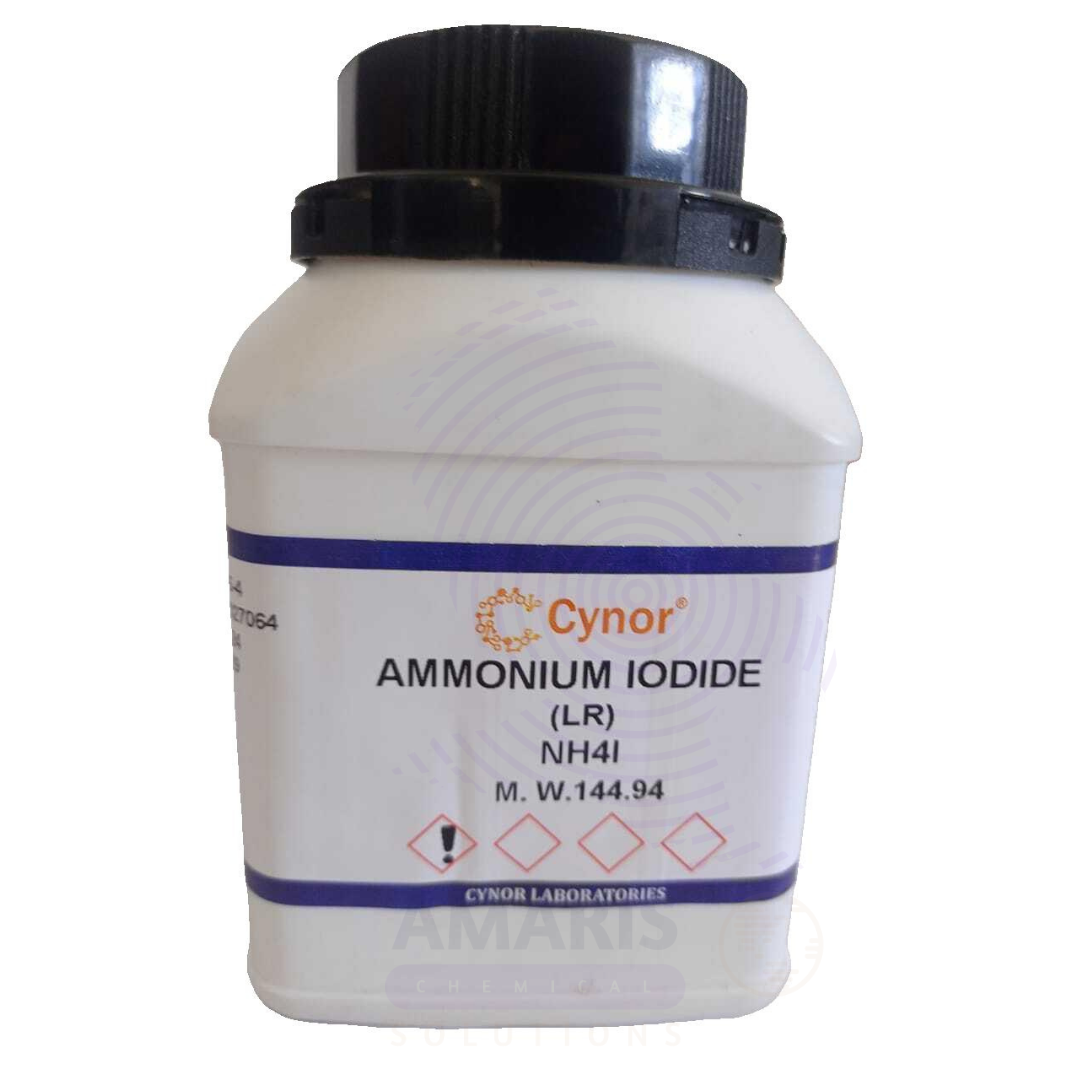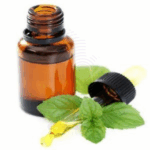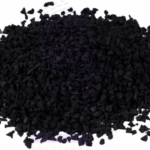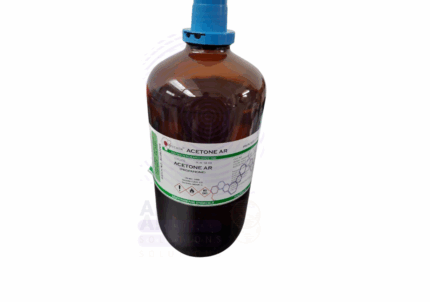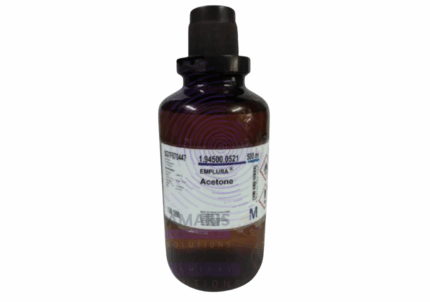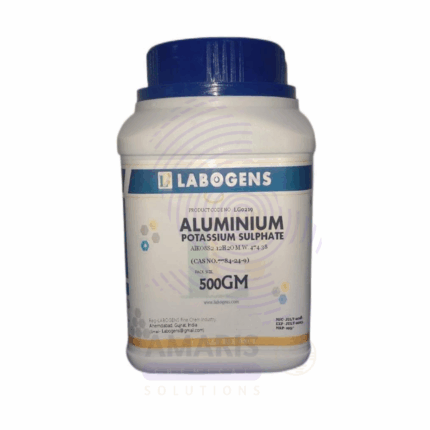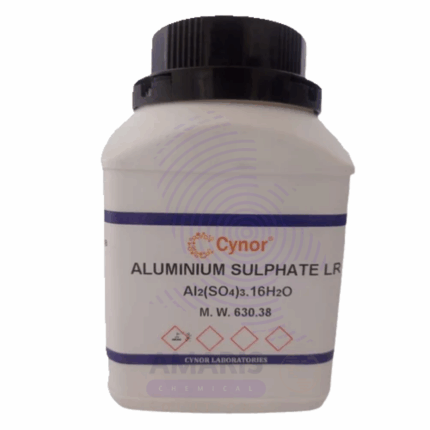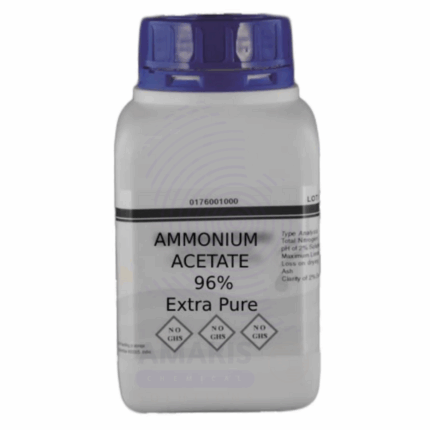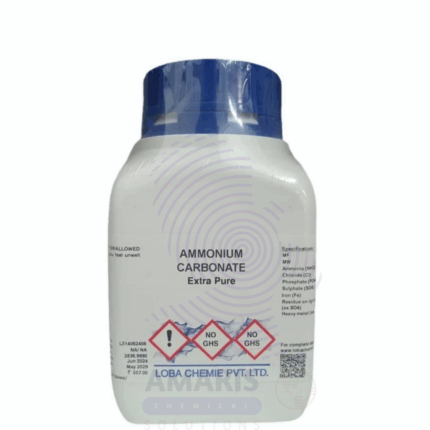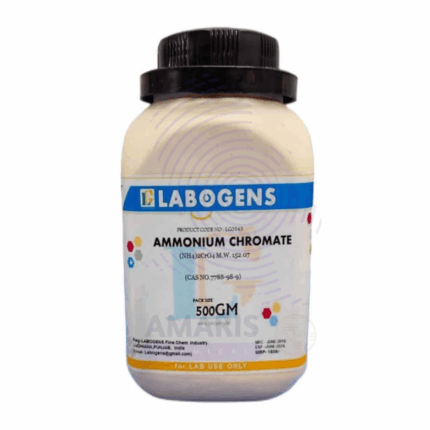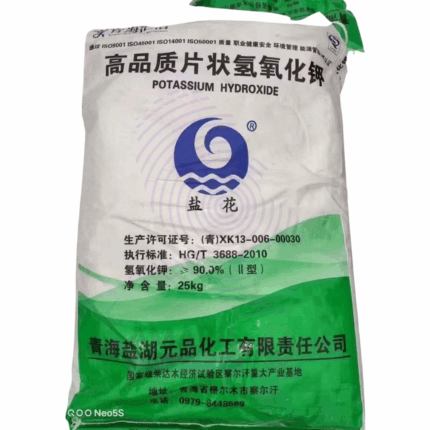Ammonium Iodide Extra Pure
$ 17.00 Original price was: $ 17.00.$ 16.78Current price is: $ 16.78.
Ammonium Iodide Extra Pure is a high-purity, white to slightly yellow crystalline compound highly soluble in water and alcohol, commonly used in laboratory chemistry for analytical, synthetic, and photographic applications. It serves as a valuable source of iodide ions in organic and inorganic reactions, including halide exchange and the preparation of iodine-containing compounds. In analytical chemistry, it is used in iodometric titrations and as a reagent for detecting metal ions. The extra pure grade ensures exceptional chemical stability and low levels of impurities, supporting accurate, reproducible results in sensitive experiments. It should be stored in tightly sealed containers, away from light and moisture, to prevent decomposition and discoloration.
Ammonium Iodide Extra Pure
Primary Uses
- Source of Iodide Ions in Analytical Chemistry
- Supplies I⁻ ions for halide tests, redox titrations, or precipitation reactions (e.g., with silver nitrate).
- Precursor in Organic Synthesis
- Used in iodination reactions, as a nucleophilic source of iodine in substitution or coupling chemistry.
- Reagent in Redox Chemistry
- Involved in iodine/iodide redox systems, useful in demonstrating oxidation-reduction equilibrium and kinetics.
- Component in Iodometric Titrations
- Used to generate free iodine in the presence of oxidizing agents (e.g., Cu²⁺, Cl₂), for quantitative redox analysis.
- Educational Demonstrations in Halide Chemistry
- Excellent for student experiments exploring reactivity trends, solubility, and acid-base reactions of halides.
Secondary Uses
- Photography and Light-Sensitive Chemistry
- Investigated in silver iodide precipitation and old photographic emulsions in research or historical chemistry contexts.
- Crystallization Studies
- Sometimes used to demonstrate salt crystal growth and behavior under different humidity or temperature conditions.
- Model Compound in Environmental Chemistry
- Used in studying iodide transport, sorption, and redox conversion in simulated groundwater or ocean systems.
- Intermediate in Preparation of Organic Iodides
- Supplies iodide for formation of alkyl iodides, aryl iodides, or iodinated drugs in synthetic methods.
- Demonstration of Air Sensitivity and Decomposition
- Decomposes slowly in moist air, releasing iodine — useful in teaching decomposition and stability of halide salts.
| PACK SIZE |
100 grams Plastic Tin |
|---|
1. Basic Identification Attributes
- Chemical Name: Ammonium Iodide
- CAS Number: 12027-06-4
- HS Code: 28276000 (Iodides and iodide oxides)
- Molecular Formula: NH₄I
- Synonyms:
- Ammonium monoiodide
- Iodic acid ammonium salt
- Ammonium iodide (1:1)
2. Physical & Chemical Properties
- Physical State: Solid (crystalline powder)
- Color & Odor: White to pale yellow crystals; odorless (may darken over time due to iodine release)
- Boiling Point: Decomposes
- Melting Point: ~551°C
- Density/Specific Gravity: ~2.51 g/cm³
- Solubility:
- Water: Freely soluble (~176 g/100 mL at 25°C)
- Alcohol: Soluble
- pH Level: ~5.0–6.0 (in 5% aqueous solution; slightly acidic)
- Vapor Pressure: Negligible
- Flash Point: Not flammable
- Autoignition Temperature: Not applicable
- Viscosity: Not applicable
3. Safety & Hazard Attributes
- Hazard Class (GHS):
- Eye Irritation (Category 2A)
- Skin Irritation (Category 2)
- Specific Target Organ Toxicity – Repeated Exposure (Category 2, thyroid)
- NFPA Ratings:
- Health: 2
- Flammability: 0
- Reactivity: 1
- Exposure Limits:
- No specific OSHA/ACGIH limits
- Use general precautions for iodide salts
- Reactivity:
- Light-sensitive; decomposes on exposure to air and light, releasing iodine
- Incompatible with strong oxidizing agents and acids
4. Storage & Handling Attributes
- Storage Conditions:
- Store in tightly sealed, amber containers
- Protect from moisture, heat, and light
- Incompatible Materials:
- Acids, oxidizers, bromine, chlorine
- Container Type:
- Amber glass or HDPE containers with air-tight lids
- Shelf Life & Expiration Date:
- ~2 years if protected from air/light
- Special Handling Requirements:
- Use gloves, goggles, lab coat
- Avoid inhaling dust; handle in a ventilated space
5. Regulatory & Compliance Attributes
- Regulatory Status:
- Listed under TSCA, REACH
- Iodide salts regulated in some jurisdictions due to potential thyroid effects
- Transportation Restrictions:
- Not regulated for normal lab quantities
- Waste Disposal Method:
- Avoid release into drains
- Neutralize and dispose via approved chemical waste handler
6. Environmental & Health Impact
- Ecotoxicity:
- Harmful to aquatic life at high concentrations
- Persistence in Environment:
- Iodide ions may persist and bioaccumulate in aquatic environments
- Carcinogenicity/Mutagenicity:
- Not classified as carcinogenic
- May affect thyroid hormone production upon long-term exposure
- Biodegradability:
- Inorganic; not biodegradable but environmentally manageable in small amounts
SAFETY PRECAUTIONS
- Personal Protective Equipment (PPE):
- Wear a lab coat, chemical splash goggles, and nitrile or neoprene gloves.
- Use a fume hood or ensure good ventilation—this salt can release iodine vapors in moist air.
- Handling:
- Avoid inhalation of dust or vapors and contact with skin and eyes.
- Handle with care in a dry environment—ammonium iodide is hygroscopic and can decompose in moist air.
- Avoid mixing with strong acids or oxidizing agents (can release iodine or toxic gases).
- Storage:
- Store in a tightly closed container in a cool, dry, and well-ventilated location.
- Protect from light, moisture, and heat.
- Store separately from acids, oxidizers, and light-sensitive substances.
- Hygiene Measures:
- Wash hands thoroughly after handling.
- Clean work areas after use and avoid spreading contamination.
- Do not eat, drink, or smoke in the lab.
FIRST AID MEASURES
- Inhalation:
- Move the person to fresh air immediately.
- If breathing is difficult, provide oxygen and seek medical attention.
- Vapors or dust may cause irritation to the nose and throat.
- Skin Contact:
- Rinse skin thoroughly with soap and water.
- Remove any contaminated clothing and launder before reuse.
- Seek medical attention if irritation develops.
- Eye Contact:
- Rinse cautiously with plenty of water for 15 minutes.
- Hold eyelids open to ensure thorough flushing.
- Seek immediate medical attention if irritation persists.
- Ingestion:
- Rinse mouth with water.
- Do not induce vomiting.
- If the person is conscious, give water to dilute.
- Seek immediate medical attention—iodide salts in high doses can cause thyroid and gastrointestinal effects.
FIRE FIGHTING MEASURES
- Suitable Extinguishing Media:
- Use dry chemicals, carbon dioxide (CO₂), alcohol-resistant foam, or water spray depending on the surroundings.
- Specific Hazards:
- Not flammable, but may decompose when heated to release toxic vapors, including:
- Iodine gas (I₂)
- Ammonia (NH₃)
- Nitrogen oxides (NOₓ)
- Not flammable, but may decompose when heated to release toxic vapors, including:
- Protective Equipment for Firefighters:
- Wear self-contained breathing apparatus (SCBA) and full protective gear.
- Firefighting Instructions:
- Cool containers exposed to fire with water spray.
- Avoid inhalation of decomposition fumes.
- Prevent runoff from entering drains or water bodies—toxic to aquatic life.
Related products
Acetone Extra Pure
Aluminium Metal Fine Extra Pure
Aluminium Potassium Sulphate Hydrated Extra Pure
Aluminium Sulphate Anhydrous Extra Pure
Ammonium Acetate Extra Pure
Ammonium Carbonate Extra Pure
Ammonium Carbonate Extra Pure is a high-quality, white crystalline solid widely used across various scientific, industrial, and food-related applications. Manufactured to stringent purity standards, this compound is ideal for laboratories and processes that demand high-grade reagents. With its characteristic ammonia-like odor and ability to decompose upon heating, ammonium carbonate plays a versatile role in both chemical reactions and physical processes.
In aqueous solution, ammonium carbonate breaks down into ammonium bicarbonate and ammonium carbamate, further releasing ammonia (NH₃) and carbon dioxide (CO₂) upon heating. This property makes it especially useful in applications that require controlled gas release or temporary pH modification.


 Preservatives(food)
Preservatives(food) Flavor Enhancers
Flavor Enhancers Acidulants
Acidulants Sweeteners
Sweeteners Antioxidants
Antioxidants Colorants(food)
Colorants(food) Nutraceutical Ingredients (food)
Nutraceutical Ingredients (food) Nutrient Supplements
Nutrient Supplements Emulsifiers
Emulsifiers
 Collectors
Collectors Dust Suppressants
Dust Suppressants Explosives and Blasting Agents
Explosives and Blasting Agents Flocculants and Coagulants
Flocculants and Coagulants Frothers
Frothers Leaching Agents
Leaching Agents pH Modifiers
pH Modifiers Precious Metal Extraction Agents
Precious Metal Extraction Agents
 Antioxidants(plastic)
Antioxidants(plastic) Colorants (Pigments, Dyes)
Colorants (Pigments, Dyes) Fillers and Reinforcements
Fillers and Reinforcements Flame Retardants
Flame Retardants Monomers
Monomers Plasticizers
Plasticizers Polymerization Initiators
Polymerization Initiators Stabilizers (UV, Heat)
Stabilizers (UV, Heat)
 Antifoaming Agents
Antifoaming Agents Chelating Agents
Chelating Agents Coagulants and Flocculants
Coagulants and Flocculants Corrosion Inhibitors
Corrosion Inhibitors Disinfectants and Biocides
Disinfectants and Biocides Oxidizing Agents
Oxidizing Agents pH Adjusters
pH Adjusters Scale Inhibitors( water)
Scale Inhibitors( water)
 Antioxidants(cosmetic)
Antioxidants(cosmetic) Emollients
Emollients Fragrances and Essential Oils
Fragrances and Essential Oils Humectants
Humectants Preservatives
Preservatives Surfactants(cosmetic)
Surfactants(cosmetic) Thickeners
Thickeners UV Filters
UV Filters
 Fertilizers
Fertilizers Soil Conditioners
Soil Conditioners Plant Growth Regulators
Plant Growth Regulators Animal Feed Additives
Animal Feed Additives Biostimulants
Biostimulants Pesticides (Herbicides, Insecticides, Fungicides)
Pesticides (Herbicides, Insecticides, Fungicides)
 Active Pharmaceutical Ingredients (APIs)
Active Pharmaceutical Ingredients (APIs) Excipients
Excipients Solvents(pharmaceutical)
Solvents(pharmaceutical) Antibiotics
Antibiotics Antiseptics and Disinfectants
Antiseptics and Disinfectants Vaccine Adjuvants
Vaccine Adjuvants Nutraceutical Ingredients (pharmaceutical)
Nutraceutical Ingredients (pharmaceutical) Analgesics & Antipyretics
Analgesics & Antipyretics
 Analytical Reagents
Analytical Reagents Solvents(lab)
Solvents(lab) Chromatography Chemicals
Chromatography Chemicals Spectroscopy Reagents
Spectroscopy Reagents microbiology-and-cell-culture-reagents
microbiology-and-cell-culture-reagents Molecular Biology Reagents
Molecular Biology Reagents Biochemical Reagents
Biochemical Reagents Inorganic and Organic Standards
Inorganic and Organic Standards Laboratory Safety Chemicals
Laboratory Safety Chemicals Specialty Laboratory Chemicals(Special Laboratory Equipment)
Specialty Laboratory Chemicals(Special Laboratory Equipment)
 Demulsifiers
Demulsifiers Hydraulic Fracturing Fluids
Hydraulic Fracturing Fluids Scale Inhibitors(oil)
Scale Inhibitors(oil) Surfactants(oil)
Surfactants(oil) Drilling Fluids
Drilling Fluids
 Dyes and Pigments
Dyes and Pigments Bleaching Agents
Bleaching Agents Softening Agents
Softening Agents Finishing Agents
Finishing Agents Antistatic Agents
Antistatic Agents
 Admixtures
Admixtures Waterproofing Agents
Waterproofing Agents Sealants and Adhesives
Sealants and Adhesives Curing Compounds
Curing Compounds Concrete Repair Chemicals
Concrete Repair Chemicals Anti-Corrosion Coatings
Anti-Corrosion Coatings
 Surfactants(cleaning)
Surfactants(cleaning) Builders
Builders Enzymes
Enzymes Solvents (Cleaning)
Solvents (Cleaning) Fragrances
Fragrances
 Electronic Chemicals
Electronic Chemicals Catalysts
Catalysts Lubricants
Lubricants Photographic Chemicals
Photographic Chemicals Refrigerants
Refrigerants Automotive chemicals
Automotive chemicals Pyrotechnic Chemicals
Pyrotechnic Chemicals
 Biodegradable Surfactants
Biodegradable Surfactants Bio-based Solvents
Bio-based Solvents Renewable Polymers
Renewable Polymers Carbon Capture Chemicals
Carbon Capture Chemicals Wastewater Treatment Chemicals
Wastewater Treatment Chemicals
 Pigments
Pigments Solvents(paint)
Solvents(paint) Specialty Coatings
Specialty Coatings Binders/Resins
Binders/Resins Additives
Additives Driers
Driers Anti-Corrosion Agents
Anti-Corrosion Agents Functional Coatings
Functional Coatings Application-Specific Coatings
Application-Specific Coatings
 Fresh Herbs
Fresh Herbs Ground Spices
Ground Spices Whole Spices
Whole Spices Spice Blends
Spice Blends Dried Herbs
Dried Herbs
 Leavening Agents
Leavening Agents Dough Conditioners
Dough Conditioners Flour Treatments
Flour Treatments Fat Replacers
Fat Replacers Decoratives
Decoratives Preservatives(baking)
Preservatives(baking)
 Plasticizers & Softeners
Plasticizers & Softeners Reinforcing Agents
Reinforcing Agents Adhesion Promoters
Adhesion Promoters Vulcanizing Agents
Vulcanizing Agents Antidegradants
Antidegradants Blowing Agents
Blowing Agents Fillers & Extenders
Fillers & Extenders Accelerators & Retarders
Accelerators & Retarders